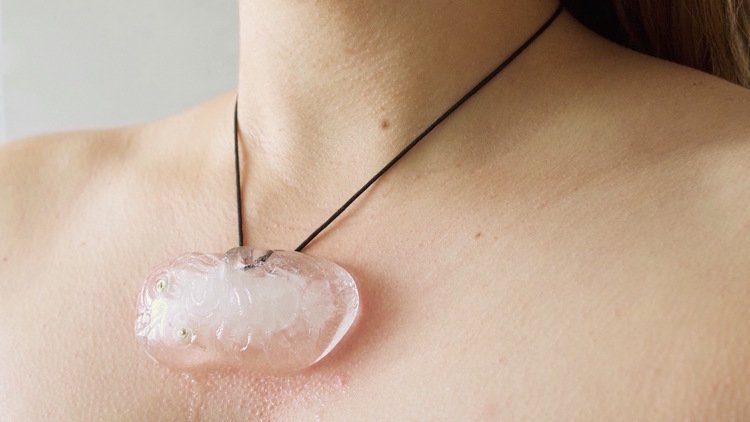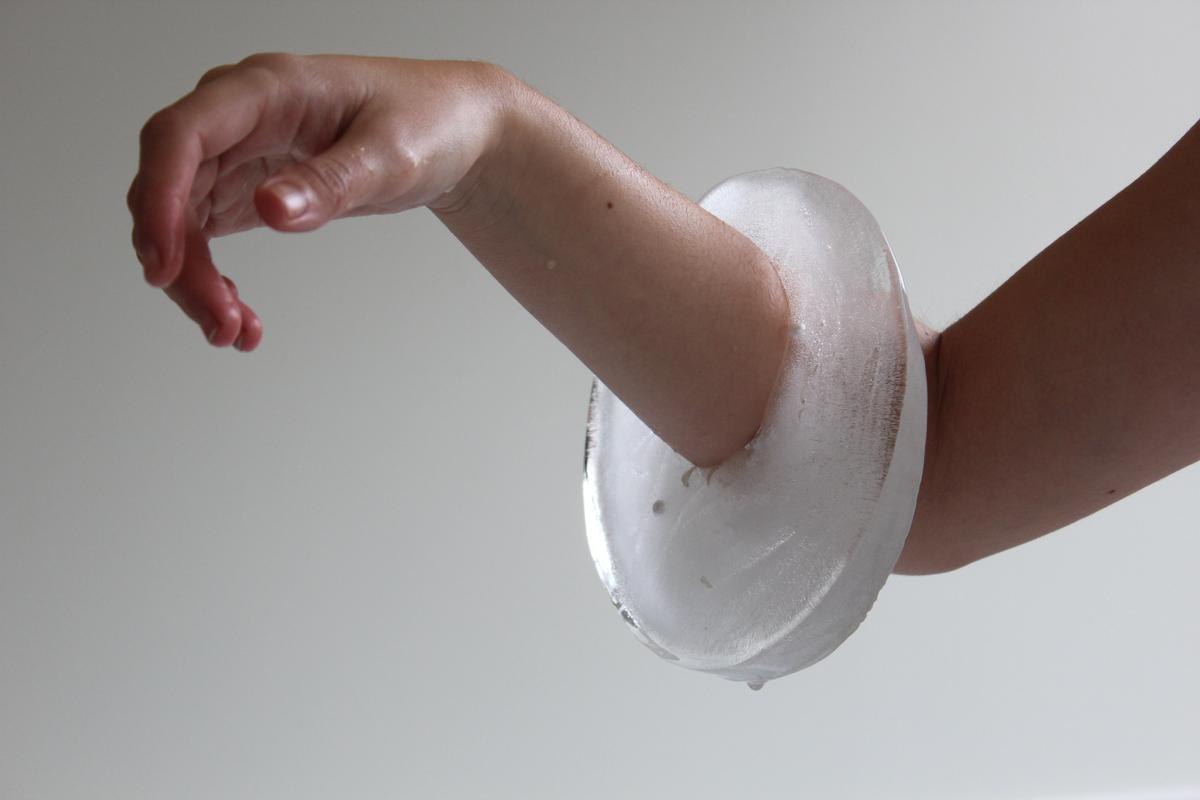We look before we see. It looks as if it were light as air; as if sweet breath plumped it up. When we look for longer, we can see that it changes shape, leaves a mark and grows ever heavier on the arm that wears it.
Made of ice, it is not just cold, but painful to the touch. The longer it is worn (or held on the bearers arm) the more the object becomes less tangible and more slippery. Inside the bracelet—once free in water, now trapped in ice, melting slowly in real time, but in abrasive temporal leaps for the viewer, hair, fingernails and pearls are slowly released, falling away from the arm that wears it.
Originally exhibited in 2014 as part of curator Daniel Michael Satele’s group show and "virtual exhibition", The Drowned World(1), Jasmine Te Hira’s Lost Content (2013), is a metaphorical expression for the many seasons it can take to recover from the grief of losing a loved one. It is difficult to see the objects embedded in the bracelet as they fall away, either because of one’s screen size when watching online (such as in The Drowned World) or the relatively miniscule size and shape of the objects themselves.
Te Hira draws this tightrope tension between presence and absence ever more taut by channeling multiple influences from her cultural own background as an artist of New Zealand Māori, Cook Islands and English descent.
The work reflects Māori notions of the tapu (sacredness) of the bodies of the deceased, and especially pertains to the levels of tapu around the time of death. An individual’s level of tapu, a powerful and untouchable spiritual and social code, increases at the end of one’s life and, as such, can also imbue places and objects with the sacred, potentially dangerous power. After death, the place and the person’s possessions will have tapu cleansed or removed by a tohunga, or priest. This is to ensure that those who come in contact with the objects are not put in danger. Fresh water, with its special connection to Tangaroa, the God of the ocean, has the power to neautralise tapu levels and cleanse tapu spaces. In turn, water sprinkled on the body lowers tapu and so, embedding DNA and embodying an object (bracelet) with frozen water neutralises the danger it can cause the bearer whilst also distilling and purifying in the process.
In the pre-photographic era, Victorians would create a physical artefact to serve as a trace to the person and the signifier for their representation. These traditions—which themselves date back to the Middle Ages when skulls and crossbones served as physical reminder of death—demonstrated a sentimental appreciation of lost life and an immortalisation of their otherwise perishable loved ones. An adornment piece was also considered to be sacred, as it held something of the essence of the person within it. Likewise, in Lost Content Te Hira embeds jewellery items in the ice as a gesture towards remembering and holding onto the indexical trace of the person. In applying her own disparate influences around death and sacred objects to the work, Te Hira makes the transience of the bracelet even more powerful; the essence cannot be held. Furthermore, the tapu is neutralised, thus changing the makers relationship to the object and the person it holds, remembers or represents.
In an interview with Radio New Zealand in 2014(2), Te Hira remarked that the work has a personal significance in relation to her own water birth, and in how water can also be used in a spiritual sense to facilitate conversations with ancestors. She also explained that a member of her family had passed away around the time she made the work. In freezing and then allowing that ice to melt, Te Hira attempts to exert some form of ownership over the process of mourning, to distil what has happened, to capture some essence of her own grief and then to allow it to pass, slowly, painfully, viscerally and felt, over her body. Te Hira also sees the morphing and changing of the ice as a process that connects to landscapes.
In Lost Content the artist’s arm is shown in four split screens, each offering slightly different perspectives on the same event. Within each frame there are both subtle and jarring differences, affording a sense of chaos or drama to an otherwise quiet work. It is as if Te Hira wants each part of her ancestry to break free from their rules, codes and parameters, so that she can make sense of the overwhelming and difficult process we know as grief.

Still from Lost Content (2014), Jasmine Te Hira
Three of the four hands begin in slightly disparate states of openness, as if willing or ready to hold onto something. The fourth is closed. Perhaps it is not ready to take on anything at all, or perhaps it is clenched as it braces itself for the icy adornment. It might also suggest solidarity to the viewer and an alliance with loved ones lost.
At first, Te Hira makes only minor changes; an intentional glitch or jump cut. Twenty-eight seconds in, the frames changes entirely. Suddenly, the closed fist is now an open hand, reaching out. In the bottom left, the hand is now facing down, having shifted from an upward, hopeful gesture to a defeated one, heavy from the weight of the ice bracelet that hangs from a bodily hinge, the wrist.
Whether Te Hira filmed multiple versions of this event or, if each frame is a component of the singular event is irrelevant. Each section remains distinct within the whole. Te Hira’s compositing of the four images affords the work a sense of fractiousness and slightly varied repetition, which communicates inescapability and endlessness, reflecting many individuals’ experience of grief.
Shortly after, another, more dramatic shift takes place in the video. The hand in the bottom left has submitted to the movement; its palm tilted up, exposing its vulnerability but also accepting the weight of the bracelet and the necessary passage of time. Meanwhile, in the upper left screen, the hand holds the bracelet as if it were a ring, transferring power from the object to the bearer. It is held up almost as an object of worship, one that the arm is proud to show it has a hold on; as if it were possible to have a hold over one’s grief.
As time passes, the arm becomes more visibly red with the piercing pain that the ice causes to its touch. We are now acutely aware of how the process wears differently on both the bearer and the thing itself; where the ice is held, or where it rests, has become thinner than at other points around the circle. Though the duration of the work suggests something steady about the process of grief, the glitches, cuts, edits and uneven spread of the melting process reveal its ultimately unpredictable and uncontrollable nature.
Soon, a third and wholly dramatic change takes place. In the lower two images the bracelet slips away from the arm altogether. Up top, we see the bracelet has moved to the elbow and, it seems, closer to the wrist. If I were to imagine that these are four distinct processes then the hand that was holding the bracelet is now only just managing to keep it in the nook of a supportive elbow. So, too, has the once closed fist now changed tilt to face the viewer directly, in a half open gesture. The bracelet, too, is facing us, and Te Hira’s limb emerges from it. Somehow this feels more violent, yet it is also evidence of the way in which people try to move through grief, pushing outward, as it envelops them.
Later, a revelation hits: the transience of the bracelet is far more visible than before. In the bottom left there is only a pained, red arm. In the bottom right, there is nothing at all. Above, an arm wilts under the weight of the process whilst another holds its position, only to have the bracelet fall away from it completely. The looped glitch in the top left reminds us of the repetition of grief and the way in which it can start up again, or take you right back to where you were before.
The arm in the top right is now able to move. It is free of the weight of loss, and yet, it mimics the arm movement next to it, stuck in a memory glitch, condemned to repeat the performance of pain. Even when free of the physical weight of grief, its repercussions and its permanence persist; the empty square is no more comforting to me as a viewer than the pained arm that came before it.
For Te Hira, the bracelet moves further away from the hand as it melts, just as the relationship to the dead morphs from a physical to a more spiritual realm. For me, the slippage reinforces the conflict of her mixed heritage. Melting and distorting the perfect shape of the circle, it is as if the trapped elements of Te Hira’s Māori and Cook Islands ancestry were trying to escape the confines and traditional shape of colonial rule.
Elements of this remarkable work are repeated in her more recent piece, The Beauty of Invisible Grief (2016). Running at eleven minutes and fifty-five seconds as an online video, the piece was originally exhibited on a video screen trapped inside a glass casing, sat on top of a wooden side table. Presented in installation as a commentary and example of ‘cultural artefact’, the work originally ran at forty-two minutes and was accompanied by layered audio recordings.

Still from The Beauty of Invisible Grief (2016) Jasmine Te Hira
Presented completely silent in its online counterpart, the video has a singular view, through an archway that resembles a door, or perhaps a keyhole, and reminds the viewer that their view is partial; no matter how hard and long we look, we will never see the full picture.
Here, Te Hira has cast a necklace pendant in ice, melting slowly onto her chest. Because of the placement, we can see the pace of her breath and even the mechanism of her throat as she swallows, waiting for the object to make safe passage from a hardened, tangible thing to an ungraspable elemental compound.
For this work, Te Hira collected samples of water from three individual rivers of her whakapapa (genealogy). The documentation of the water is recorded by the wearer but also in the digital image and, by way of extension, by he/she who bears witness—the viewer. For Te Hira, the translation from gallery to online video is difficult, as the physicality of the work is important to her in its communication. Still, what the online videos offer is a lesson in looking and seeing.
While I have been unable (for geographical reasons) to view the works in their intended installation settings, the space that Te Hira’s bare composition gives the images is so large that it is deafening. More than eighteen thousand miles across oceans and land mass, I am deeply moved when I don’t just look, but really see the images in her work. Whether her hand is open, closed, or reaching, there is life in every gesture.
